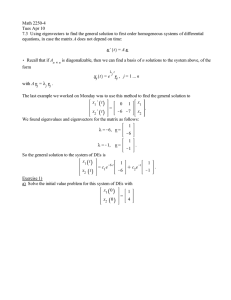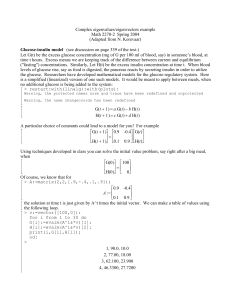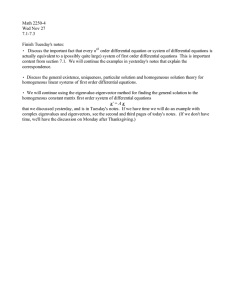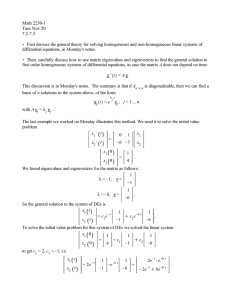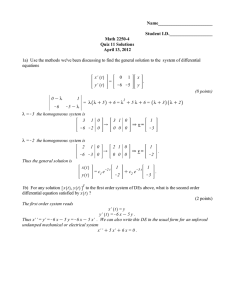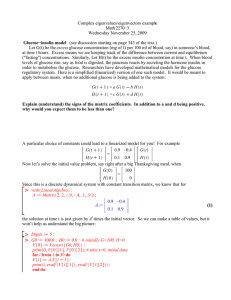Math 2250-4 Mon Dec 2
advertisement
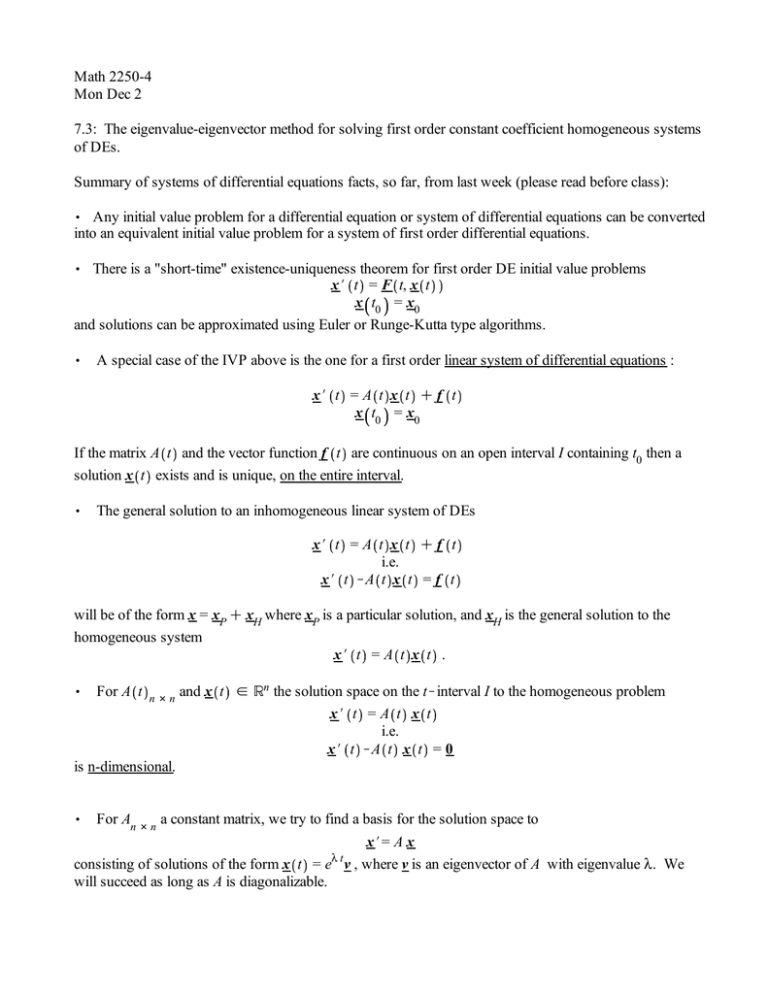
Math 2250-4 Mon Dec 2 7.3: The eigenvalue-eigenvector method for solving first order constant coefficient homogeneous systems of DEs. Summary of systems of differential equations facts, so far, from last week (please read before class): , Any initial value problem for a differential equation or system of differential equations can be converted into an equivalent initial value problem for a system of first order differential equations. , There is a "short-time" existence-uniqueness theorem for first order DE initial value problems x# t = F t, x t x t0 = x0 and solutions can be approximated using Euler or Runge-Kutta type algorithms. , A special case of the IVP above is the one for a first order linear system of differential equations : x# t = A t x t C f t x t0 = x0 If the matrix A t and the vector function f t are continuous on an open interval I containing t0 then a solution x t exists and is unique, on the entire interval. , The general solution to an inhomogeneous linear system of DEs x# t = A t x t C f t i.e. x# t KA t x t = f t will be of the form x = xP C xH where xP is a particular solution, and xH is the general solution to the homogeneous system x# t = A t x t . , For A t n #n and x t 2 =n the solution space on the tKinterval I to the homogeneous problem x# t = A t x t i.e. x# t KA t x t = 0 is n-dimensional. For An # n a constant matrix, we try to find a basis for the solution space to x#= A x lt consisting of solutions of the form x t = e v , where v is an eigenvector of A with eigenvalue l. We will succeed as long as A is diagonalizable. , Exercise 1a) Use the eigenvector-eigenvalue method above to find the general homogeneous solution to x1 # t x1 0 1 = . x2 # t K6 K7 x2 b) Solve the IVP with x1 0 x2 0 = 1 4 . Exercise 2a) What second order overdamped initial value problem is equivalent to the first order system IVP on the previous page. And what is the solution function to this IVP? b) What do you notice about the Chapter 5 "Wronskian matrix" for the second order DE in 2a, and the Chapter 7 "Wronskian matrix" for the solution to the equivalent first order system in 1a? c) Since in the correspondence above, x2 t equals the mass velocity x# t = v t , I've created the pplane phase portrait below using the lettering x t , v t T rather than x1 t , x2 t T . Intepret the behavior of the overdamped mass-spring motion in terms of the pplane phase portrait. d) How do the eigenvectors show up in the phase portrait, in terms of the direction the origin is approached from as t/N, and the direction solutions came from (as t/KN)? http://math.rice.edu/~dfield/dfpp.html So far we've not considered the possibility of complex eigenvalues and eigenvectors. Linear algebra theory works the same with complex number scalars and vectors - one can talk about complex vector spaces, linear combinations, span, linear independence, reduced row echelon form, determinant, dimension, basis, etc. Then the model space is Cn rather than =n . Definition: v 2 Cn (v s 0) is a complex eigenvector of the matrix A, with eigenvalue l 2 C if Av=lv. Just as before, you find the possibly complex eigenvalues by finding the roots of the characteristic polynomial A K l I . Then find the eigenspace bases by reducing the corresponding matrix (using complex scalars in the elementary row operations). The best way to see how to proceed in the case of complex eigenvalues/eigenvectors is to work an example. There is a general discussion on the page after this example that we will refer to along the way: Glucose-insulin model (adapted from a discussion on page 339 of the text "Linear Algebra with Applications," by Otto Bretscher) Let G t be the excess glucose concentration (mg of G per 100 ml of blood, say) in someone's blood, at time t hours. Excess means we are keeping track of the difference between current and equilibrium ("fasting") concentrations. Similarly, Let H t be the excess insulin concentration at time t hours. When blood levels of glucose rise, say as food is digested, the pancreas reacts by secreting insulin in order to utilize the glucose. Researchers have developed mathematical models for the glucose regulatory system. Here is a simplified (linearized) version of one such model, with particular representative matrix coefficients. It would be meant to apply between meals, when no additional glucose is being added to the system: G# t K0.1 K0.4 G = H# t 0.1 K0.1 H Exercise 3a) Understand why the signs of the matrix entries are reasonable. Now let's solve the initial value problem, say right after a big meal, when G 0 100 = H 0 0 3b) The first step is to get the eigendata of the matrix. Do this, and compare with the Maple check on the next page. > with LinearAlgebra : 1 10 K > Ad 2 5 K 1 1 K 10 10 Eigenvectors A ; ; 1 10 2 5 K A := K 1 10 1 1 C I 10 5 1 10 K K 1 1 K I 10 5 K Notice that Maple writes a capital I = , 2 I K2 I 1 1 K1 . 3c) Extract a basis for the solution space to his homogeneous system of differential equations from the eigenvector information above: 3d) Solve the initial value problem. (1) Here are some pictures to help understand what the model is predicting ... you could also construct these graphs using pplane. (1) Plots of glucose vs. insulin, at time t hours later: > with plots : > G d t/100$exp K.1$t $cos .2$t : H d t/50$exp K.1$t $sin .2$t : plot1 d plot G t , t = 0 ..30, color = green : plot2 d plot H t , t = 0 ..30, color = brown : display plot1, plot2 , title = `underdamped glucose-insulin interactions` ; underdamped glucose-insulin interactions 100 60 0 10 20 t 30 2) A phase portrait of the glucose-insulin system: > pict1 d fieldplot K.1$G K .4$H, .1$G K .1$H , G =K40 ..100, H =K15 ..40 : soltn d plot G t , H t , t = 0 ..30 , color = black : display pict1, soltn , title = `Glucose vs Insulin phase portrait` ; Glucose vs Insulin phase portrait 40 30 H 20 10 K40 K10 20 40 60 80 100 G , The example we just worked is linear, and is vastly simplified. But mathematicians, doctors, bioengineers, pharmacists, are very interested in (especially more realistic) problems like these. Solutions to homogeneous linear systems of DE's when matrix has complex eigenvalues: x# t = A x Let A be a real number matrix. Let l = aCb i ∈ ℂ v = a C i b 2 Cn satisfy A v = l v , with a, b 2 =, a, b 2 =n . , Then z t = el t v is a complex solution to x# t = A x lt because z # t = le v and this is equal to A z = A el t v = el t A v = el t l v . , But if we write z t in terms of its real and imaginary parts, z t =x t Ciy t then the equality z# t = A z 0 x# t C i y# t = A x t C i y t = A x t C i A y t . Equating the real and imaginary parts on each side yields x# t = A x t y# t = A y t i.e. the real and imaginary parts of the complex solution are each real solutions. , If A a C i b = a C b i a C i b then it is straightforward to check that A aKi b = aKb i aKi b . Thus the complex conjugate eigenvalue yields the complex conjugate eigenvector. The corresponding complex solution to the system of DEs e a K i b t aKi b = x t K i y t so yields the same two real solutions (except with a sign change on the second one).
